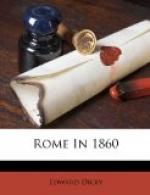and the piazza is emptier, quieter, and cleaner than
the street, but that is all. You stop and enter
the first church or two, but your curiosity is soon
satisfied. Dull and bare outside, the churches
are gaudy and dull within. When you have seen
one, you have seen all. A crippled beggar crouching
at the door, a few common people kneeling before the
candle-lighted shrines, a priest or two mumbling at
a side-altar, half-a-dozen indifferent pictures and
a great deal of gilt and marble everywhere, an odour
of stale incense and mouldy cloth, and, over all,
a dim dust-discoloured light. Fancy all this,
and you will have before you a Roman church.
On your way you pass no fine buildings, for to tell
the honest truth, there are no fine buildings in Rome,
except St Peter’s and the Colosseum, both of
which lie away from the town. Fragments indeed
of old ruins, porticoes built into the wall, bricked-up
archways and old cornice-stones, catch your eye from
time to time; and so, on and on, over broken pavements,
up and down endless hills, through narrow streets
and gloomy piazzas, by churches innumerable, amidst
an ever-shifting motley crowd of peasants, soldiers,
priests, and beggars, you journey onwards for two miles
or so; you have got at last to the modern quarter,
where hotels are found, and where the English congregate.
There in the “Corso,” and in one or two
streets leading out of it, there are foot-pavements,
lamps at night, and windows to the shops. A
fair sprinkling of second-rate equipages roll by you,
bearing the Roman ladies, with their gaudy dresses,
ill-assorted colours, and their heavy, handsome, sensual
features. The young Italian nobles, with their
English-cut attire, saunter past you listlessly.
The peasants are few in number now, but the soldiers
and priests and beggars are never wanting. These
streets and shops, brilliant though they seem by contrast
with the rest of the city, would, after all, only be
third-rate ones in any other European capital, and
will not detain you long. On again by the fountain
of Treves, where the water-stream flows day and night
through the defaced and broken statue-work; a few steps
more, and then you fall again into the narrow streets
and the decayed piazzas; on again, between high walls,
along roads leading through desolate ruin-covered
vineyards, and you are come to another gate.
The French sentinels are changing guard. The
dreary Campagna lies before you, and you have passed
through Rome.
And when our stroll was over, that sceptic and incurious fellow-traveller of mine would surely turn to take a last look at the dark heap of roofs and chimney-pots and domes, which lies mouldering in the valley at his feet. If I were then to tell him, that in that city of some hundred and seventy thousand souls, there were ten thousand persons in holy orders, and between three and four hundred churches, of which nearly half had convents and schools attached; if I were to add, that taking in novices, scholars, choristers, servitors,




